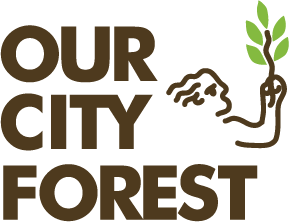What is Bare Roots and why should I volunteer for this?
Our City Forest receives a large shipment of bare root trees around early February/ March each year. This amount can range anywhere from 1200-1800+ trees depending on the current inventory and future demand for trees.
These trees are essential for our projects and residents who need a tree.
What happens before and during the event?
"Treench" Preparation:
We create multiple long trenches of soil amendment to temporarily store the bare root trees a few weeks ahead of the delivery date.
Tools and Materials Preparation:
Old pots are scrubbed and stakes are sanitized ahead of time.
We use soil that are either premixed by a vendor or hand-mixed on site.
Tree Arrival & Processing:
Incoming trees are unloaded and inspected on arrival. They would arrive in bundles of 5-10 or in a VigorLiner®.
Trees are then sorted and tagged by their species.
Bundles of trees are immediately placed in the "treench" to protect their roots from drying out while VigorLiner® trees are placed on pallets to be grouped by species.
Trees arrived in a VigorLiner®
Trees arrived in bundles
Trees are root pruned to avoid root-girdling
Tree Care:
Trees are pruned and checked for health and structure.
Regular watering of the treench during this process is a must.
Transplanting
When ready, trees are removed from the "treench," to be once again inspected for quality and receive any necessary root pruning.
Trees is now ready to be transplanted into 15-gallons pots!
Quality Control
Trees passing quality checks will be thoroughly watered and then moved into their designated rows.
Quality Control
Trees passing quality checks will be staked, leader tied and thoroughly watered before they are moved into their designated rows.
Why is Bare Roots important?
Provides a significant number of trees that Our City Forest uses for the following planting seasons.
Offers valuable hands-on experience for volunteers and Sillicon Valley Climate Corps members.
How can I get involved?
Volunteer: We welcome volunteers to assist with various tasks before, and during Bare Roots such as trench and materials preparation, tree transplants, and tree moves.
Donations: Your financial support helps us continue doing our work. Thank you for your support!
For more information or to volunteer, please visit ourcityforest.eventbrite.com or email Lowell@ourcityforest.org


















